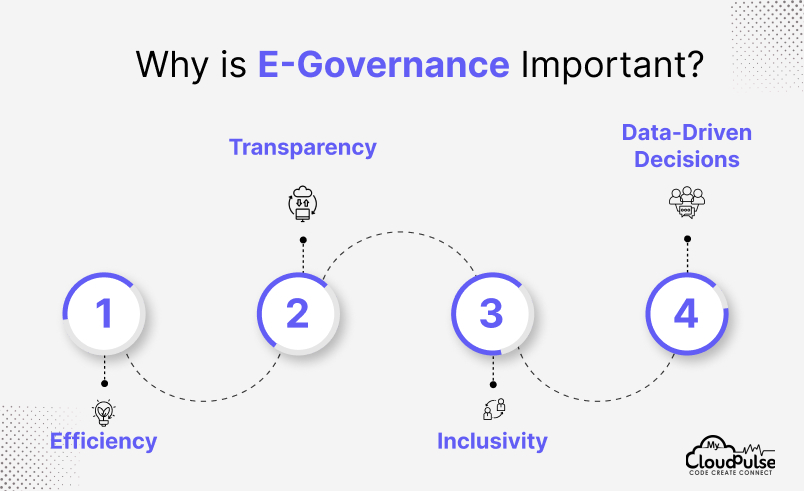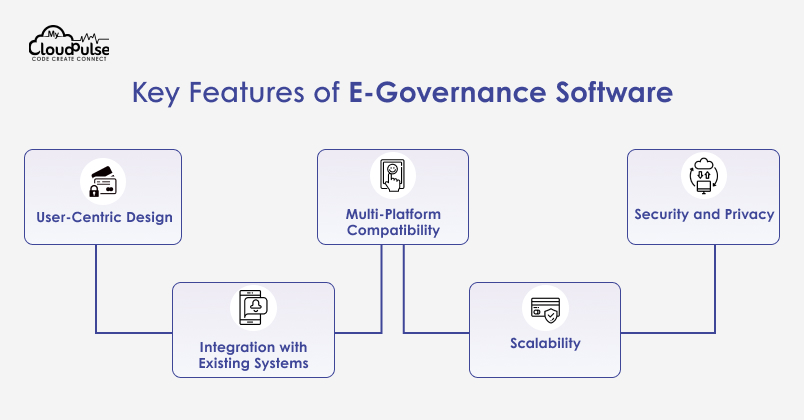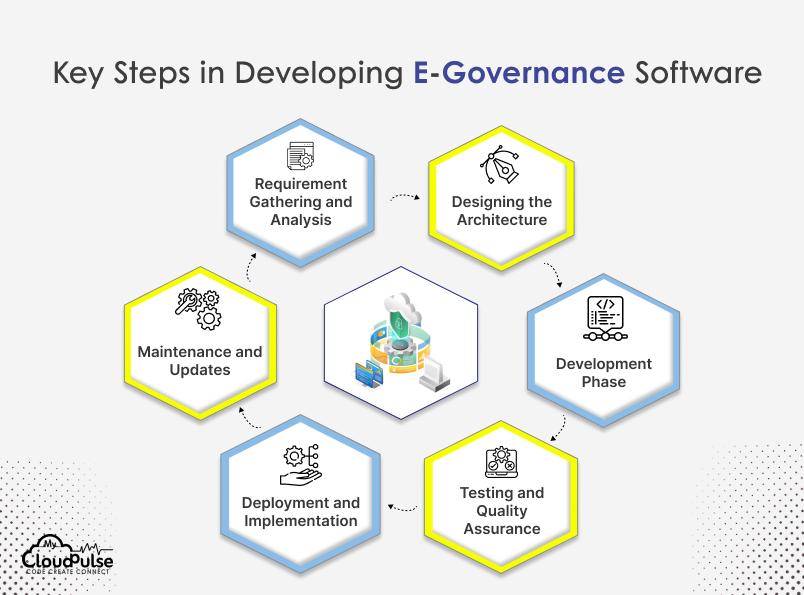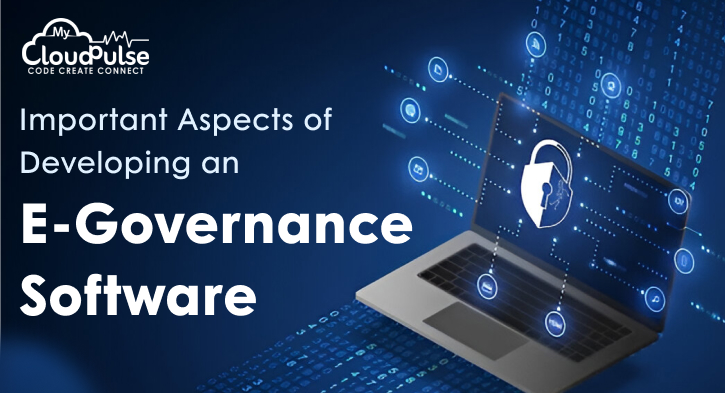Think of a world where paying taxes, applying for permits, and accessing public services without needing to stand in line or fill out tedious paperwork. E-governance software promises you to bring government services to your fingertips with just a few clicks.
But developing an efficient e-governance system is not as simple as creating a website. It requires an advanced security system, with compliance followed by technological automation and full integration with a host of third-party solutions. With the demand for scalability skyrocketing, governments have begun looking for cost-effective solutions for the provision of items that can grow with technical advances.
The software development team at CloudPulse, with their expertise, can develop secure, scalable, and AI-backed e-governance solutions. Our team assists governments in creating efficient, citizen-centric platforms that can improve public service offerings.
Understanding E-Governance
Governments around the world embrace digital transformation to ensure faster governance and transparent processes. Be it tracking welfare benefits, applying for business licenses, or lodging complaints, a structured and well-defined e-governance platform eliminates any bureaucratic delays, ensuring seamless interactions between governments and citizens.
At its core, e-governance software is an electronic platform allowing smooth interactions between the government organizations, citizens, corporations, and civil servants. The platform enables the bureaucracy in the process of accessibility to services ranging from simple processes of recording births or deaths, obtaining a passport, filing taxes, offering services to the right people, etc.
Key Stakeholders in E-Governance
A successful e-governance serves various stakeholders:
- Citizens: The key recipients of government services, from basic amenities to advanced services.
- Businesses: Individual businesses help in simplifying basic government processes.
- Government: Provides a robust infrastructure for public data management, work process automation, and improved governance.
- Employees: Key players in providing human resource management, payroll, and remote work.
Why is E-Governance Important?
In the past, people had to physically visit government offices, fill out paperwork, and wait for long periods to access services. But with the advent of e-governance, citizens can now avail themselves of government services from the comfort of their homes, saving both time and effort. Here are some compelling reasons why e-governance is essential:

- Efficiency: By moving processes online, administrative tasks that once took weeks or months are now completed within hours or even minutes.
- Transparency: E-governance allows citizens to track their requests or applications in real time. This transparency helps reduce corruption and ensures that the process is more accountable.
- Inclusivity: Digital platforms make government services accessible to people in rural areas or those with limited mobility. Services such as online applications, e-payments, and virtual consultations remove barriers to accessibility.
- Data-Driven Decisions: Governments can analyze vast amounts of data to gain insights into areas needing improvement, thereby creating better-informed policies.
Challenges in Traditional Governance
Traditional governance models, reliant on paper-based systems and face-to-face interactions, often face several challenges:
- Inefficiency: Manual paperwork and lengthy approval processes lead to delays, often hindering the timely delivery of services.
- Lack of Transparency: Without a transparent tracking system, citizens are left in the dark about the status of their applications or requests.
- Limited Accessibility: For citizens, especially in rural or underdeveloped areas, accessing government services can be cumbersome and costly.
E-governance software addresses all these challenges by digitizing processes and bringing services closer to the people.
Key Features of E-Governance Software Development
Developing effective e-governance software is more than just building an application or website. It requires thoughtful consideration of various factors that ensure the platform is functional, secure, and user-friendly. Below are the key features that e-governance software must have:

1. User-Centric Design
The success of e-governance software development depends on how accessible and user-friendly the platform is. Governments serve a wide demographic of people, from tech-savvy urban citizens to those with limited digital experience. This makes designing an intuitive, user-friendly interface essential. Here’s why:
- Simplicity and Ease of Use: Government websites or portals should avoid complex processes and provide simple, clear instructions to guide users through the process. For example, the design should support a step-by-step approach with intuitive navigation that minimizes confusion.
- Accessibility: Accessibility features such as voice assistance for the visually impaired, simple language support for non-tech-savvy users, and easy-to-read fonts for those with learning disabilities are crucial.
- Multi-Language Support: In multilingual countries like India, it’s essential to offer services in various languages to ensure that everyone has access to government services, regardless of their language.
2. Multi-Platform Compatibility
Citizens interact with digital platforms across a variety of devices – smartphones, tablets, laptops, and desktop computers. Therefore, e-governance platforms need to be accessible and responsive across all these devices.
- Mobile Compatibility: A significant number of people, particularly in emerging economies, access the internet primarily through mobile phones. Ensuring that the e-governance software is fully optimized for mobile devices is crucial.
- Cross-Browser Compatibility: E-governance software should work seamlessly on all major browsers, such as Google Chrome, Mozilla Firefox, Microsoft Edge, and Safari, to reach the maximum number of users.
3. Security and Privacy
E-governance software handles sensitive data, such as personal identification information, financial details, and government records. As a result, ensuring that this data is protected is paramount. Here’s how:
- Data Encryption: All data transferred between users and the government server should be encrypted to prevent unauthorized access.
- Secure Authentication: Multi-factor authentication (MFA) helps ensure that only authorized individuals can access the platform. This is especially crucial for administrative access.
- Compliance with Data Protection Laws: Governments must ensure compliance with data privacy laws like the General Data Protection Regulation (GDPR) to guarantee that citizens’ data is handled responsibly.
4. Scalability
Governments often scale services over time, either by adding new features or by expanding the user base. E-governance software should be able to handle growing numbers of users and a large volume of data without affecting performance.
- Cloud-based Solutions: Many governments are turning to cloud infrastructure to ensure scalability. Cloud computing provides flexibility and the ability to scale resources up or down depending on demand.
- Load Balancing: Distributing traffic across several servers ensures that the platform remains responsive even when there’s a high volume of users.
5. Integration with Existing Systems
Most governments have legacy systems that store data and handle services. These older systems need to integrate with the new e-governance software to ensure seamless data flow and minimize disruption.
- APIs and Middleware: To ensure smooth data transfer between the legacy systems and the new software, developers rely on APIs and middleware solutions. These allow different systems to communicate with one another effectively.
Key Steps For E-Governance Software Development
The development of e-governance software is a long and rigorous process. Below is a step-by-step guide to ensure that the software development process is carried out efficiently.

1. Requirement Gathering and Analysis
The first step is to understand the requirements of all stakeholders involved. These include government officials, IT teams, citizens, and service providers. Conducting surveys, holding focus groups, and interviews will help gather the necessary data.
- Understanding User Needs: Engaging with citizens through consultations and feedback surveys ensures that the platform addresses the actual pain points users face when accessing government services.
- Identifying Key Features: Based on the gathered data, determine the most important features that need to be incorporated into the software, such as online application forms, payment gateways, and real-time tracking systems.
2. Designing the Architecture
Once the requirements are clear, it’s time to design the software architecture. The architecture should be designed for scalability, reliability, and modularity.
- Modular Architecture: Using a modular design ensures that the software is flexible and easy to maintain. For example, different modules can be developed independently, such as a module for registration, a module for payments, and a module for grievance redressal.
- Fault Tolerance: The system must remain operational even when parts of it fail. This can be achieved through features like failover mechanisms and redundant backups.

3. Development Phase
With a solid architecture in place, the development phase can begin. This is where developers start coding the software using suitable programming languages and frameworks.
- Choosing the Right Technology Stack: The choice of programming languages, frameworks, and databases should align with the needs of the software. Common choices for e-governance systems include Java, Python, and Node.js for the backend, and React or Angular for the front-end.
- Agile Methodology: Given the dynamic nature of e-governance, it’s beneficial to adopt agile methodologies that allow for iterative development and constant feedback loops. This helps make adjustments based on real-time testing.
4. Testing and Quality Assurance
Thorough testing is essential to ensure the software is reliable, secure, and bug-free.
- Performance Testing: Test the software’s performance to ensure it can handle large numbers of users and data.
- Security Testing: Vulnerability assessments and penetration testing help identify security flaws before the software is deployed.
- User Testing: Beta testing with a select group of users allows developers to fine-tune the user interface and improve usability.
5. Deployment and Implementation
Once tested and refined, it’s time to deploy the software. This should be done in phases to ensure a smooth rollout.
- Pilot Testing: Start by launching the software in a limited geographic region to identify any issues or user challenges before full deployment.
- Training and Support: Train government employees and citizens on how to use the system effectively. Provided ongoing technical support to help users with any issues.
6. Maintenance and Updates
E-governance software requires continuous maintenance. Regular updates, bug fixes, and security patches ensure that the software remains functional and secure.
- Feedback Loops: Continuously gather feedback from users to identify areas for improvement and new features to add.
Challenges in Developing E-Governance Software Development
Developing e-governance software is no easy task, and several challenges need to be overcome. Let’s explore some of the common challenges:
1. Technical Challenges
Integrating e-governance software with legacy systems is one of the biggest hurdles. Many governments still use outdated systems that were not built for digital transformation. Additionally, poor internet connectivity in some areas can limit the effectiveness of digital services.
2. Financial Constraints
Governments, especially in developing countries, often operate on tight budgets, making it difficult to allocate sufficient resources for the development of robust e-governance platforms.
3. Resistance to Change
Employees within the government may be reluctant to adopt new technologies, and citizens may face challenges with digital literacy. Overcoming this resistance requires training, education, and continuous support.
4. Ensuring Inclusivity
One of the biggest challenges in e-governance is ensuring inclusivity. Rural populations may not have access to the internet, and older citizens may struggle to use digital platforms. Ensuring that the system is accessible to everyone, regardless of their location or technical ability, is crucial.
Conclusion
The development of e-governance software is a transformative process that enables governments to offer better services, engage citizens more effectively, and ensure greater transparency. While there are significant challenges, the benefits far outweigh them. By focusing on user-centric design, security, scalability, and integration, governments can create platforms that improve the delivery of public services and create lasting value for citizens.
As technology continues to evolve, so too will e-governance. By embracing future trends like artificial intelligence, blockchain, and smart governance, governments can usher in a new era of efficient, transparent, and inclusive governance.
By developing robust e-governance software, we can build a stronger, more connected society—one where technology is used to its full potential for the benefit of all.

FAQs(Frequently Asked Question)
The primary purpose of e-governance software is to simplify and enhance the delivery of government services to citizens by utilizing digital technology. It aims to improve efficiency, transparency, and accessibility while reducing administrative bottlenecks.
Effective e-governance software incorporates several key features:
User-Centric Design: A simple and intuitive interface that caters to all citizens, including those with limited digital literacy.
Security and Privacy: Strong encryption, secure authentication methods, and adherence to data protection laws ensure that sensitive information is protected.
Data security is crucial in e-governance platforms, as they handle sensitive personal and financial information. Governments implement multiple layers of security measures to safeguard this data:
Data Encryption: All data transmitted between users and government servers is encrypted to prevent unauthorized access.
Multi-Factor Authentication (MFA): This process requires users to provide multiple forms of verification to access the system, ensuring that only authorized individuals can access sensitive data.
Developing e-governance software comes with its own set of challenges:
Technical Challenges: Integrating the new software with outdated legacy systems and dealing with internet connectivity issues in remote areas.
Resistance to Change: Both government employees and citizens may resist adopting new digital systems, particularly in regions with low digital literacy.
E-governance software brings numerous benefits to citizens:
Time and Convenience: Citizens no longer need to visit government offices in person, saving time and effort by accessing services online.
Transparency and Accountability: Real-time tracking of requests and applications ensures that citizens can monitor the progress of their interactions with the government, promoting greater accountability.


